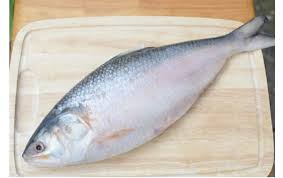According to a senior commerce ministry official, Bangladesh will stop exporting hilsa fish to India on the occasion of Durga Puja in October, ending a long-standing custom as a “goodwill gesture” to its neighbour.
According to authorities, the purpose of the export ban is to guarantee a sufficient supply of hilsa in the local market, hence maintaining the fish’s accessibility.
The interim government’s stance differs significantly from that of the Awami League government led by Sheikh Hasina, which was overthrown.
Bangladesh, the world’s largest producer of hilsa, typically lifts the export ban during the puja season. The fish is much sought-after, particularly in West Bengal, India.
Consignments of hilsa from Dhaka are given to Indians in Bangladesh as a present during the largest Hindu holy festival.
“Roughly fifty applications are pending for fish exports to India,” a senior official in the trade ministry stated. “But we have not received any export permission from the Ministry of Fisheries and Livestock this year.”
As per policy, the commerce ministry permits the export of any goods based on the opinion of the ministry concerned. In the case of hilsa, the fisheries and livestock ministry did not allow for exports this year, the official said, requesting not to be named.
Farida Akhtar, adviser to the fisheries and livestock ministry, in multiple media interviews said the interim government wants to increase hilsa supply in the domestic market.
In fiscal 2023-24, Bangladesh exported 664.86 tonnes of hilsa to India at $7.71 million, according to data from the Department of Fisheries. According to the data, 1,376.42 tonnes of hilsa worth $13.68 million were exported by Bangladesh in the fiscal year 2022–2023.
Bangladesh also has a big demand for the fish. The cost of the fish in the local market has not decreased, even with a recent increase in hilsa hauls.
Bangladesh produced a total of 571,342 tonnes of hilsa in the fiscal year 2022–2023. Fisheries data indicates that 566,593 tonnes of hilsa were produced in the fiscal year 2021–2022.
In August and September, when the fish enter rivers from the Bay of Bengal to lay eggs, hilsa is netted from the waterways. Up to 600,000 tonnes of fish are harvested by fishermen each year, with the sea providing the majority of the catch.
Hilsa was accepted as a national geographic indicator in 2017.
Even though hilsa is the national fish, many people in the marginal class still consider it to be a luxury.
In Dhaka, a piece of hilsa weighing one kilogramme (kg) is being sold between Tk 1,400 and Tk 1,600 at retail. Hilsa weighing below one kg is priced between Tk 1,100 and Tk 1,200 per kg at retail.

